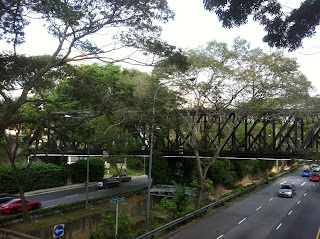For those who did not aware, following the agreement between the two governments, the land of Tanjong Pagar Railway Station shall be returned to Singapore. Thus, the operation of KTM train travelling within Singapore was ceased from 1st July 2011 onwards.
I went to have a walk along the railway from Bukit Timah Station until Railmall.
It was quite strange to walk along the railway...(never have thought of this in Malaysia... , as most of the rails are still in service). Furthermore, to see so many people also coming to walk along the rail...
, as most of the rails are still in service). Furthermore, to see so many people also coming to walk along the rail... ...sometimes really think that we have nothing better to do in Singapore...
...sometimes really think that we have nothing better to do in Singapore... ...especially if you are alone here...haha...
...especially if you are alone here...haha...
 ...especially if you are alone here...haha...
...especially if you are alone here...haha...Anyhow, a walk of about 3km along this track, you can still see some greenaries...as Singapore cannot developes the path along the railway before this...but really a lot of people...whole family...hehe...
Even some government official was here in the morning...where I saw a stage with banner along the way...Singapore has classified this as the green corridor and part of the building (train station), bridges, etc shall be maintained as heritage...
It was a hot day...Malaysians which always travel with car really cannot understand why we want to walk few kilometers to enjoy the sceneries...haha...




























 ...Singapore is still the same objective to encourage birth and mother to return to work force...
...Singapore is still the same objective to encourage birth and mother to return to work force...


